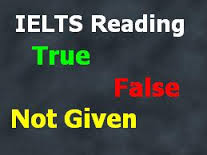I don’t know some of the words in IELTS text – what to do???
Even if the level of your English is very high, sometimes you might come across unknown words, for example some terminology from the field you are not familiar with.
Don’t panic! That’s natural! Do you know all the words in your language? I guess, you don’t. People taking IELTS come from different backgrounds and are applying for different University programmes (linguistics, physics, chemistry, astronomy, you name it), and the test is designed to be suitable for everyone. You should be able to read and understand academic texts from various fields. However it doesn’t mean that you should have broad knowledge of them or know the key terminology. You should only be able to work out the approximate meaning of these words from the context. Your task is not to understand the text and be able to talk about it, but answer the questions using the information from the text.
How to do that?
1. Read the question.
2. Highlight the key words in it.
3. Find the same key words/their synonyms in the text. Highlight them too.
4. Read the sentence(s) containing the information you are looking for, and answer the question.
It’s not hard. You just need enough practice.
What is the difference between TRUE/FALSE/NOT GIVEN and YES/NO/NOT GIVEN?
These 2 types of tasks are usually the most difficult for the students, because they require not only high level of English but also much attention and an ability to think fast.
Both tasks ask students to read the text and decide whether the statements are true (yes), false (no) or not given. The difference is that true/false/not given tasks ask about any information from the text. But yes/no/not given ask only about the author’s opinion. For example, Are the statements true, false or not given? or Do the following statements agree with the view of the writer? Do you see the difference? Anyway, the strategy of answering these questions is the same.
Watch the video lessons about yes/no/not given and true/false/not given questions.
Manage your time well
 In the listening section, you don’t have to worry about managing your time and keeping an eye on the clock. But in the reading section, you are responsible for managing your time and finishing all the tasks on time.
In the listening section, you don’t have to worry about managing your time and keeping an eye on the clock. But in the reading section, you are responsible for managing your time and finishing all the tasks on time.
There are 3 reading passages in the reading section, and you have 60 minutes to complete all tasks. Here is the tip: Reading passage 1 is usually the easiest to deal with, so train yourself to spend only 15 minutes on it. Reading passage 2 is more difficult, so allot 20 minutes for it. Reading passage 3 is usually the most difficult: it has a more complicated text and more challenging questions to answer, so spend 25 minutes on passage 3.
If you’ve spend 2-3 minutes trying to find the right answer to a question, and still can’t find it, move on. You’ll come back to this question later. After all, it’s better to skip 1 question and then try to guess the answer, then run out of time and mess out the entire test.
Unlike the listening section, you will not have time in the end to transfer your answers to the answer sheet. Put the answers in the answer sheet as you go. Don’t worry if you make a mistake, you can always correct it. The worst scenario (and I’ve seen such cases) is to answer all the questions but not to have time to transfer your answers in the answer sheet and get a ZERO for the writing section. The invigilators (people who monitor the exam) are very strict. If you continue writing after they’ve told you to finish the test and hand in the papers, you will be penalised. So fill the answer sheet out as you answer the questions.
Don’t waste your time reading the whole text
 Why? Firstly, remember that you should spend 15, 20 and 25 minutes on each text respectively – you don’t have time to read the whole text. Secondly, even if you are a fast reader, under the stressful exam conditions you are unlikely to remember what you’ve read, and to easily locate the information you need when you start answering the questions. So don’t read the text, but start answering the questions. Usually the questions are given in the logical order. For example, you can find the information for question 1 in paragraph 1; the information for question 2 – in paragraph 2, etc. But not always!
Why? Firstly, remember that you should spend 15, 20 and 25 minutes on each text respectively – you don’t have time to read the whole text. Secondly, even if you are a fast reader, under the stressful exam conditions you are unlikely to remember what you’ve read, and to easily locate the information you need when you start answering the questions. So don’t read the text, but start answering the questions. Usually the questions are given in the logical order. For example, you can find the information for question 1 in paragraph 1; the information for question 2 – in paragraph 2, etc. But not always!
Here is the strategy:
1. Read the question and underline the key words.
2. Skim the text, starting from the first paragraph. Skimming means reading quickly in order to get the main idea without focusing on details. Why do you need to skim the text? Because you want to find the same key words you underlined in the question. When you find the key words, you find the paragraph containing the answer to the question.
3. Now scan this paragraph. Scanning means reading thoroughly paying attention to details. Why do you need to scan this paragraph? Because you need to find a particular detail in this paragraph, which is the answer to this question.
4. Once you’ve found the answer in the paragraph, compare it against the given options (A,B,C,D) and choose the one with the same meaning. Remember the wording in the paragraph may differ from the wording in the answer options. But their meaning must be the same. If the meaning is the same, it means that it’s the right answer.
The same strategy applies to the gap-fill questions. Here you don’t have A,B,C,D options (multiple choice), but you have a sentence which you need to complete with exactly the same word from the text. This word must fit the given sentence grammatically and stylistically. If it doesn’t, then it is the wrong word. Go back to the text and look for the right one.
 Which questions to answer first?
Which questions to answer first?
Group 1. In IELTS Reading there are questions relating to specific information in the text, such as Multiple choice, True/false/not/given, Yes/no/not given, gap-fill, sentence completion, etc. In a word, these are questions the answers to which you can find in 1 or 2 sentences. You use the key words in the question, you find the same key words (or their synonyms) in the text, and you figure out the meaning. So answer these questions first, because it’s easier and less time-consuming to find the answers to them.
Group 2. However there are questions relating to the entire paragraph or even text, such as Matching headings (when you have several headings and you need to match them to the paragraphs in the text) and matching features (when you have details and you need to figure out which paragraphs mention them). For these questions you need to read the entire text to find out the answer, so you will have to spend much more time on them. That’s why answer them after you’ve answered more “local” questions (like the ones described above). Why? Because in order to answer the first group of questions you will have to go through the whole text anyway. Thus, you will kill two birds with one stone: you will answer the questions and you will read the text. By the time you start answering the second group of questions, you will have read the text and understood the main idea of each paragraph. So you will have an idea where to look for information for Matching headings and Matching features questions.
 True/False/Not given: explained
True/False/Not given: explained
In this question you see a number of statements and you must decide if they are true, false or not given. You must write ‘True’, ‘False’ or ‘Not given’ in the answer sheet.
If you can find exactly the same sort of information in the text (the words might be different but the meaning is absolutely the same), it means that the statement is TRUE.
If the information in the text contradicts the statement, it means that it’s FALSE. A good way to check this is to transform the statement into a question, and ask yourself: “Does the text say this?”. For example, your statement might be something like “The research indicates that nowadays more young people prefer digital learning to traditional learning”. You should ask yourself a series of questions to get it right: Is research mentioned at all? If yes, does it show that more people prefer digital learning to traditional learning? If yes, is it about nowadays? and so on. Make sure you ask a question about each particular word in this sentence. If at some point, you say “no”, and find the information that contradicts the statement, then it is false. For example, if in the text you read something like “In his research, Professor Smith discovered that digital learning is gaining popularity with older generation of people, and replacing traditional learning”. Everything is similar apart from 1 word. The text tells you about older people, but the statement is about young people. So when you ask yourself: “Is the research about young people?” Your answer will be: “No, it’s about older people” (the information in the text contradicts the statement).
But this question is more tricky than that. It’s not only about true or false. The information may not be given, or may partly be not given. Let’s take the same example about Professor Smith. The sentence in the text may be ““In his research, Professor Smith discovered that digital learning is gaining popularity with younger generation of people”. This seems true, but it misses out a part of the information in the statement. It doesn’t mention traditional learning at all. We see that digital learning is gaining popularity with young people. But the text doesn’t say that young people prefer digital learning over traditional learning. That is why you write NOT GIVEN.
 Matching headings: explained
Matching headings: explained
This type of question is similar to matching information. But here you are not looking for specific information, you are looking for the main idea. There is a list of headings which are identified by Roman numerals (i, ii, iii, etc.). A heading summarises the main idea of a paragraph or section of the text. You must match the heading to the correct paragraph. The paragraphs are identified by letters (A, B, C, etc.). There will always be more headings than paragraphs or sections, so some headings will not be used. It is also possible that some paragraphs may not be included in the task. One or more paragraphs or sections may already be matched with a heading as an example on the question paper. No heading may be used more than once.
You should read the paragraph and catch the main idea. Ask yourself: “If I had to use only 1 sentence to summarise the whole paragraph, what would it be”. Once you have this sentence in your head, look at the list of headings and choose the one that summarises the paragraph you’ve just read. Remember they are not in the right order. For example, paragraph A may be matched with heading iii, etc. Don’t get trapped. Some headings identify specific information from the paragraph, that is the idea is mentioned, but it is not the main idea. To be a good heading for the paragraph, it should summarise the whole information from this paragraph.

